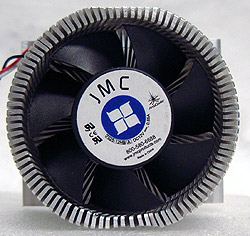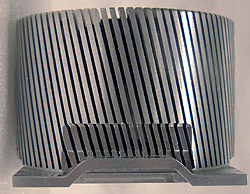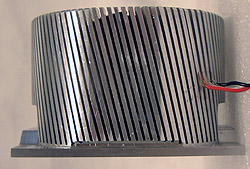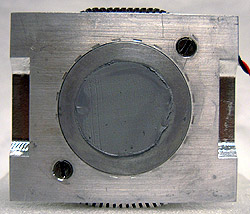
|
|
89%
Abstract: The original Agilent heatsink
was made for socket 370 Pentium III processors, but this version is intended for use with socket 478 Pentium 4's.
|
Home >
Reviews >
Page: Taking a look at the heatsink from all sides
|
| JMC 401100 Heatsink From All
Angles |
 |
The Fan:
The fan is 67mm in diameter and surrounded by a 21mm wall
of aluminum fins. Each aluminum fin is 1.2mm thick and spaced about
1mm apart. Rotating at 5500RPM, the
fan is glued in place and comes with a nice long power cable that
supports RPM monitoring. As you might be able to see
behind the impeller, the fins are cut all the way back to
the motor base. This provides a clear path for exhaust air to leave
the heatsink as opposed to simply a flat surface. |
 |
Side A:
From this side we can see the slight
angle with which the fins have been cut from the solid aluminum. Each fin
is cut all the way down to the base with a circular blade so the inside
geometry is gently sloped outwards. The baseplate is stepped to enable the
spring clips for a socket 478 configuration to grip firmly, and the heatsink is
notched out for clearance. The base plate is 3mm thick, but is not in direct
contact with the processor heatspreader. The overall height of the cooler is 52mm.
|
 |
Side B:
To keep the heatsink within width
specs, JMC have machined the sides on two faces flat. The base of
the finned area is also notched out on all sides for clearance of various components.
The three power cables coming from the fan are glued in place which
is good to see. Left free, it is possible that the wires may come
loose and cause the impeller to bind. |
 |
Heatsink Base:
The base of this particular
heatsink isn't much to look at, but remember this is not a final example
of a retail version. The heatsink comes with a pre-installed circle of
thermal compound - though it looks as though a little too much was applied
in this case. The finned section is inserted into the aluminum
base and crimped into place. For added measure, this heatsink also had machine
screws used, but since the processor only makes contact with the finned section
it really doesn't matter how well the base plate is attached, just so
long as it doesn't ever come loose. Base finish is machined flat
and fairly good. The surface is smooth, but there is a
small dimple at the center. |
|
 |
Websites you may also like:
PCSTATS
|
|
 |


